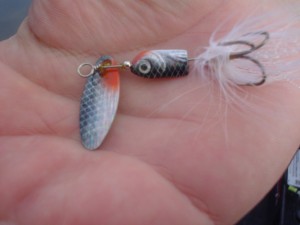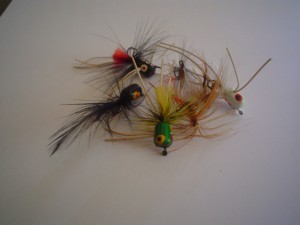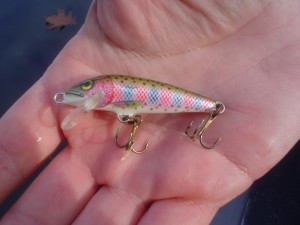If you are a novice or veteran fisherman looking to stock up on some new fishing gear it is easy to be overwhelmed walking down the fishing isle of your local Walmart or Bait Shop. Don’t fret my friend as I will hopefully shed some light on making the right selection. If will definitely help knowing at least what kind of fishing you will be doing. Will you be freshwater fishing or saltwater fishing? Will you be using real bait or artificial lures? Will you be bottom fishing or top fishing? Do you know what fish you will be after. Maybe your answer is yes to all of these questions. As long as you have the answer to the above questions and have an idea of how much you want to spend you should be able to make a good selection.
Be forewarned however there are numerous products that do little to attract or catch fish. They may look appealing in the store, but in practicality they fall short of delivering on the water. I would stay away from products that indicate you are guaranteed many hook ups on the water. That is always a dead giveaway to me that some sounds “fishy” (no pun intended).
If you are looking to keep your cost down and really not too concerned as the quality of the merchandise you purchase I would head to you local Walmart or Benny’s location. They do have some quality products, but most of their merchandise is rather generic. There prices are also fairly lower than what you will pay at a sporting store. If you are looking for higher quality tackle then I would head to a “Dick’s Sporting Goods” or your local bait shop. If you plan on fishing saltwater expect to pay a little more as the tackle is generally larger than the freshwater tackle.
Below is a breakdown of the different types of artificial plugs you can choose from. I have had luck with just about all of them. In general they all produce fish, if they didn’t they would not be on the market. Also once you find a plug or lure that produces results you may want to purchase a few different colors of the same lure as on some days certain colors produce better results than others.
- Spinners

Spinner Bait Spinners generally are smaller lures that are generally used in freshwater, but I have seen them used in saltwater as well. They are characterized by a slightly curved piece of metal called a “blade” that spins around a center rod which generally has some beads or fish replica. The “blade” is attached by what is referred to as the “Clevis”. At the end of the body of the spinner is general a treble hook surrounded by a collection of thick hair called a “skirt”. Spinners are very effective when fishing for Bass, Perch, Trout, Salmon, Bluegill, Crappie and other species of fish. It is a very versatile bait. They work best in cloudy or murky water as they reflect a lot of light. They are sometimes referred to as “Rooster Tails”. Small spinners produce good results while Bluegill Fishing or Perch Fishing. Spinners are always a short reach away when I am fishing for bass or trout as they have produced many fish for me. I would say that the spinner is one of my favorite fishing lures of all time, at least for freshwater.
- Soft Plastic Lures

Soft Plastic Worm While walking down the fishing isle you may also see some lures that are made out of soft plastic. I have had good luck with soft plastic worms when fishing for freshwater bass. It takes a while to master the technique of using these lures however, you have to make the artificial plastic look like a wriggling worm, which can be a challenge at times. It does produce good results if mastered properly however. They are also common when fishing saltwater situations as well. The company named “Storm” now produces a lure called the “Storm Shad”. These I have found to be very effective for fishing for stripers in the northeast, at least in the early spring before the bluefish arrive. Many people believe that the soft plastic is like a magnet to many fishes sonar as it is more believable to the fish of prey. I cannot say enough about using soft plastics in the spring when on the pursuit of striped bass.
- Flies

Flies used for Fly Fishing Flies may not produce as well as spinners or other plugs, but they are really fun to fish with. There is something about using a dry fly on the top of the water and watching a big trout jump up and grab it with a big splash. Talk about an adrenaline rush, it is probably some of the most exciting moments I have had fishing. Flies come in many varieties, I would recommend reading the “Beginners Guide to fly Fishing” found on this site. In short you have “Dry Flies” and “Wet Flies”. Dry flies stay on the top of the surce while wet flies sink to the bottom. You can catch Trout, Bluegill, Crappie, Salmon and Bass on flies. They also come in saltwater versions for catching Striper and other larger game fish.
- Plugs
Plugs come in all sorts of different shapes and size depending apon what you are fishing for. They are very common for saltwater fishing, but popular in freshwater as well. Plugs basically try to
Baby Rainbow Trout Artificial Plug mimic a smaller fish or particular prey that you know the larger fish are feeding on at the moment. Some plugs are completely solid of one piece while others are broken into two pieces held together by a hinge. The two piece or “broken back” models generally are more vibrant in the water as they fluctuate more in the water when reeled quickly. Some plugs also have rattles built into them such that they make a sound when pulled through the water. They are referred to as “Rattlers”. When fishing for Bluefish in July and August in the northeast I used a black and white broken back rebel lure. I have tried many variations, but have found this plug to produce the best over time.
- Spoons
I heard that the history of the spoon comes from a fisherman dropping his own eating utensil overboard by mistake and then watched it plunged to the bottom. To his surprise he saw a large trout chase it to the bottom. I am not sure how accurate this story is, but that is almost exactly what a spoon looks like. I curved piece of metal (Sometimes Painted) with a hook on one end and a eyepiece on the other. I have many buddy’s that use them ofter and produce good results with them. I personally stick to my spinner as I have had more luck with spinners than spoons.
- Jigs
Jigs are used primarily catch bottom feeding fish. They generally look like a large hook with a weight surrounding it. A very common type of Jig is called the “Buck-tail Jig”. It is usually painted white with a white skirt on it. It is popular to use for flounder fishing or striped bass fishing.
This should give you at least a head start the next time you head out to stock up on some tackle for your first or next trip. Feel free to leave any questions in the comments field below and I will be happy to answer them.

